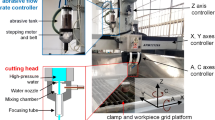Abstract
This work presents a description of abrasive water-slurry jet machining (AWSJM) to improve machining capabilities of conventional abrasive water jet machine. This work proposes a novel approach of AWSJM, where the conventional abrasive water jet machine (AWJM) is equipped with a liquid (gelatin) polymer solution injection system and a programmable control valve for controlling abrasive flow rate (AFR) and polymer solution flow rate. Parametric study of gelatin enabled AWSJM reveals the improvements in machining performance. Experimental investigations have been performed by varying concentration of the gelatin, pressure of water jet, abrasive flow rate, and abrasive size. The present work identifies the optimal range of process parameters for AWSJM, with natural gelatin as binder, with the response parameters being material removal rate, kerf width, and depth of cut. Gelatin produces a coherent, three-phase, four-content beam of higher kinetic energy in comparison with AWJ and results in increased material removal rate and depth of cut, with reduced kerf width.
Similar content being viewed by others
References
Momber AW, Kovacevic R (1998) Principles of abrasive water jet machining. Springer Verlag, London
Fairhust RM, Heron RA, Saunders, DH (1986) DIAJET—a new abrasive water jet cutting technique. In: Proceedings of 8th International Symposium on Jet Cutting Technology, 395–402
Hollinger RH, Perry WD, Swanson RK (1989) Precision cutting with a low pressure, coherent abrasive suspension jet. 5th American Waterjet Conference, 24:245–252
Brandt S, Louis H (1999) Profiling With 400 MPa fine-beam abrasive water jet. 10th American Waterjet Conference, 26:385–394
Perec A (2003) Some aspects of hydro-abrasive suspension jet cutting of marble. WJTA Am Waterjet Conf 3-A:153–165
Hashish M (1991) Cutting with high pressure abrasive suspension jets. 6th American Waterjet Conference, 33:439–455
Hashish M (1997) Machining of hard materials with abrasive-suspension jets. 9th American Waterjet Conference, 18:267–280
Devineni A (2010) A WSJ cutting of glass - an experimental study of the effect of process parameters on the depth of cut and kerf width using doe. International Conference on Mechanical and Electrical Technology (ICMET), IEEE, 978-1-4244-8102-6/10
Howells WG (1999) Super-Water® jetting applications from 1974 to 1999. 10th American Waterjet Conference, 25:367–384
Hollinger RH, Perry WD (1990) Process for cutting with coherent abrasive suspension jets. US Patent Number: 5184434
Howells WG, Imlay VL (2001) Reducing abrasive consumption by using super-water for Venturi abrasive jet cutting. Proc WJTA Am Waterjet Conf 8:114–125
Devineni A, Chincholkar AM (2009) AWSJ cutting of ceramics—an experimental study of the effect of process parameters on the surface roughness using DOE. 9th Pacific Rim International Conference on Water Jetting Technology, 161–169
Chacko SV, Gupta A, Summers DA (2003) Comparative performance study of polyacrylamide and xanthum polymer in abrasive slurry jet. 2003 WJTA Am Waterjet Conf 5-C:212–229
Deepak D, Devineni A Sharma NY (2011) Effect of diameter ratio, volume fraction and abrasive grain size on the exit velocity by numerical simulation of flowthrough abrasive water suspension jet nozzle using DOE. WJTA-IMCA Conference and Expo
Pang KL, Nguyen T, Fan JM, Wanga J (2012) Modeling of the micro-channeling process on glasses using an abrasive slurry jet. Int J Mach Tools Manuf 53:118–126
Momber AW (2001) Energy transfer during the mixing of air and solid particles into a high-speed waterjet: an impact-force study. Exp Thermal Fluid Sci 24:31–41
Miller DS (2001) Micro abrasive waterjet cutting. Proc WJTA Am Waterjet Conf 5:74–85
Patel D, Tandon P (2013) Optimization of kerf surface and material removal rate using abrasive water-slurry jet machining setup. ASME 2013 International Mechanical Engineering Congress and Exposition, pp. V02BT02A043-V02BT02A043. American Society of Mechanical Engineers
Pal VK, Tandon P (2013) Identification of the role of machinability and milling depth on machining time in controlled depth milling using abrasive water jet. Int J Adv Manuf Technol 66:877–881
Patel D, Tandon P (2015) Experimental investigations of thermally enhanced abrasive water jet machining of hard-to-machine metals. CIRP J Manuf Sci Technol. doi:10.1016/j.cirpj.2015.04.002
Ward AG, Saunders PR (1958) The rheology of gelatin. In: Eirich FR (ed) Rheology theory and applications, vol II, chapter 8. Academic, New York
Author information
Authors and Affiliations
Corresponding author
Rights and permissions
About this article
Cite this article
Patel, D., Tandon, P. Experimental investigations of gelatin-enabled abrasive water slurry jet machining. Int J Adv Manuf Technol 89, 1193–1208 (2017). https://doi.org/10.1007/s00170-016-9154-7
Received:
Accepted:
Published:
Issue Date:
DOI: https://doi.org/10.1007/s00170-016-9154-7



